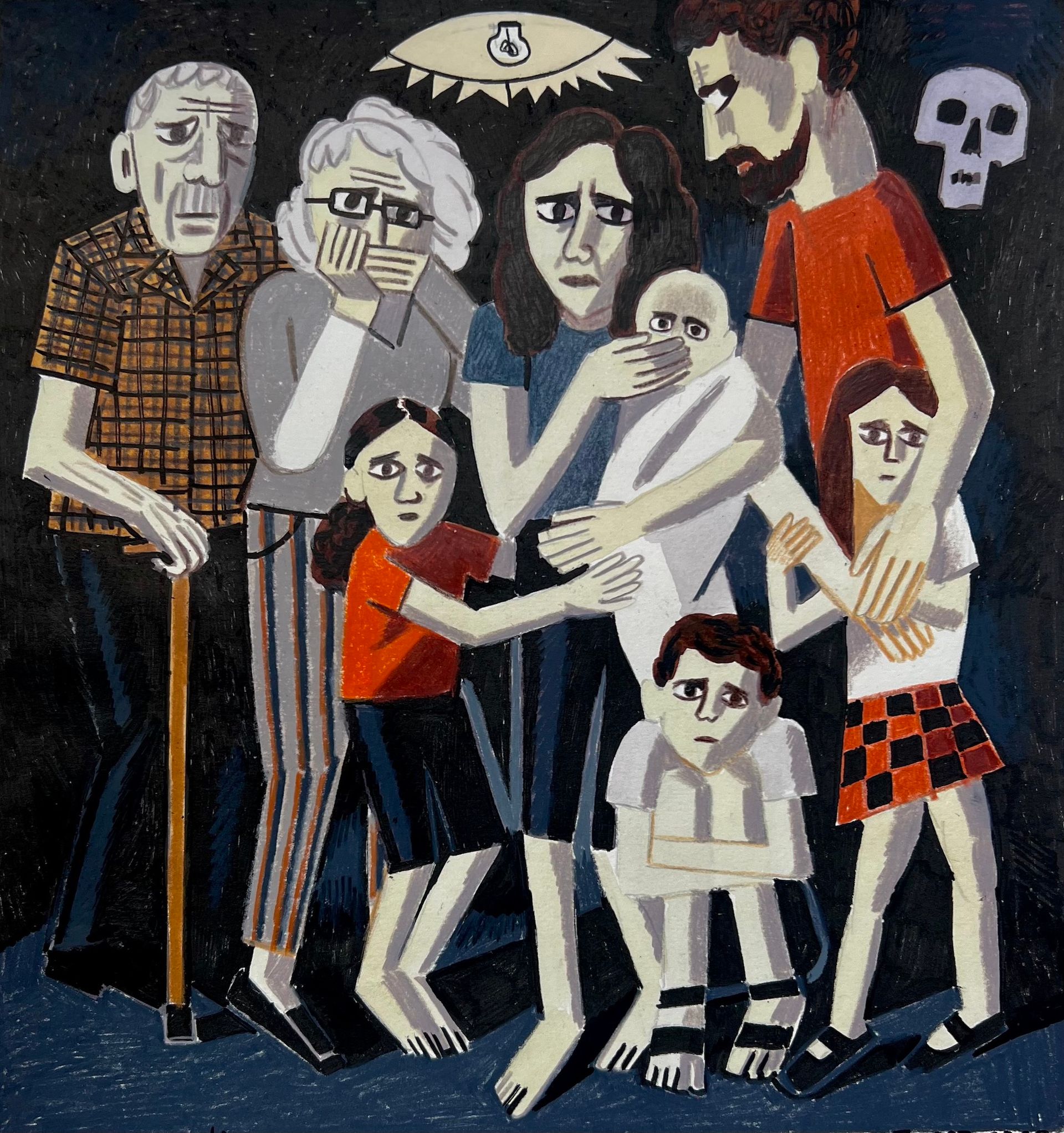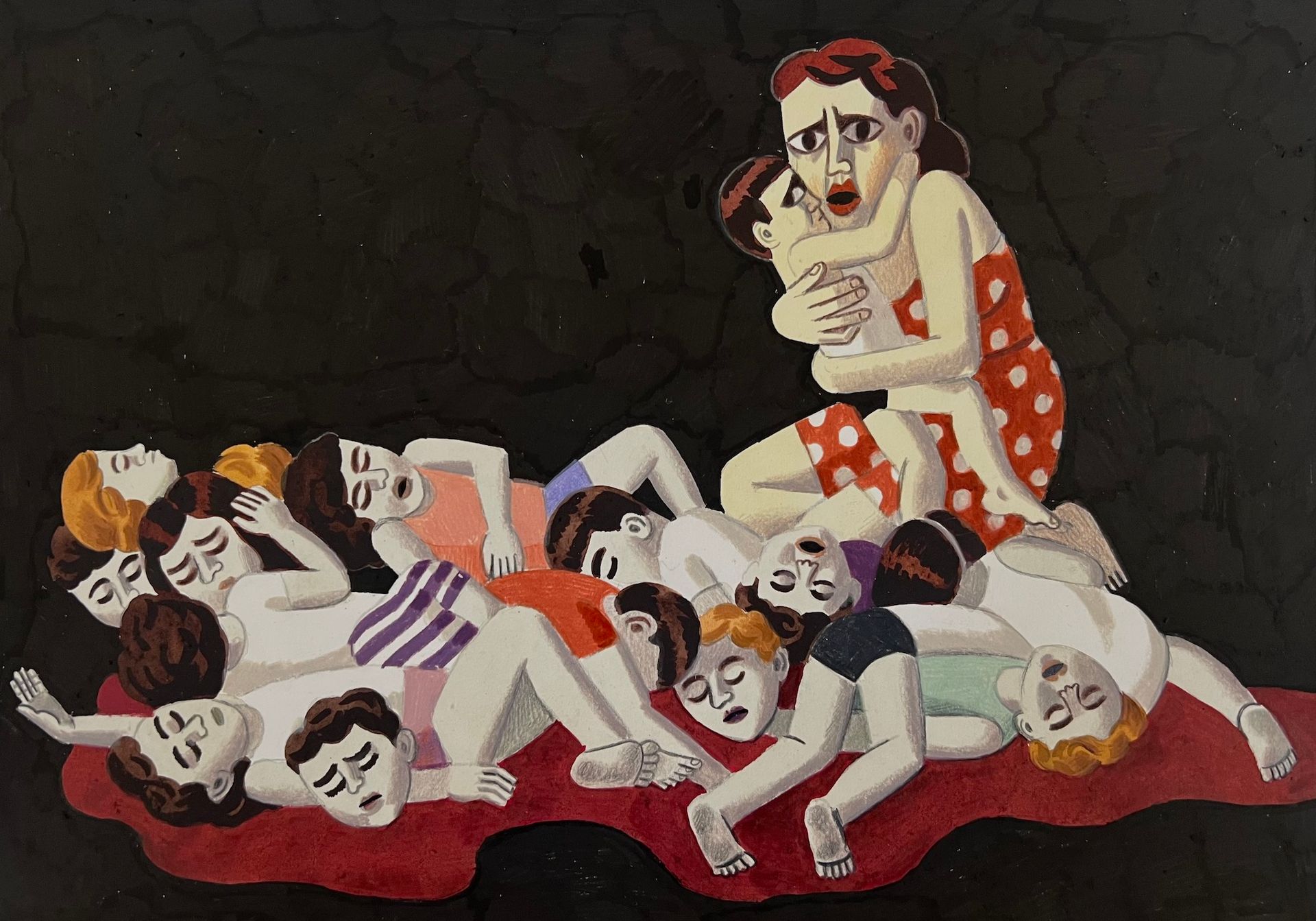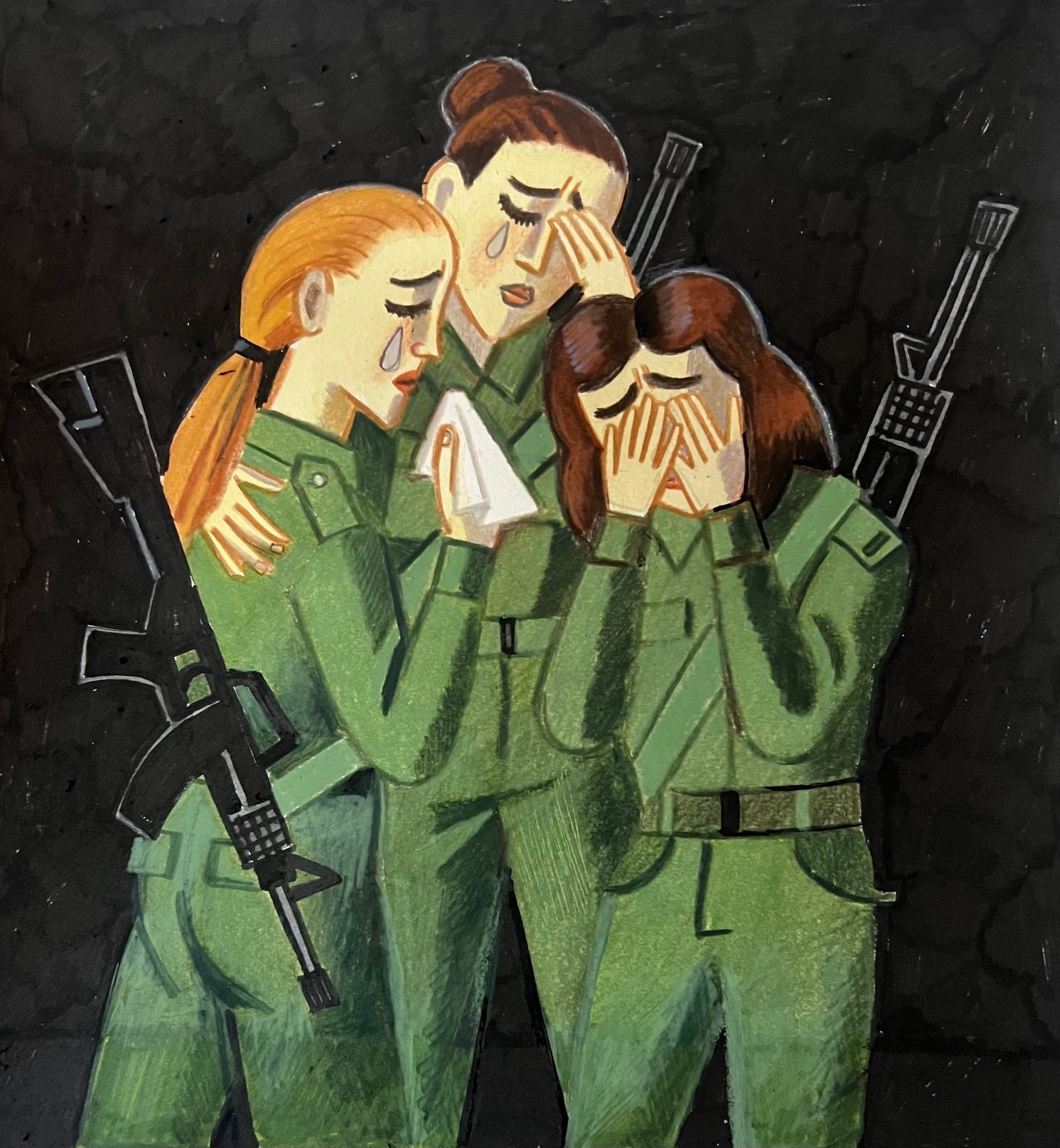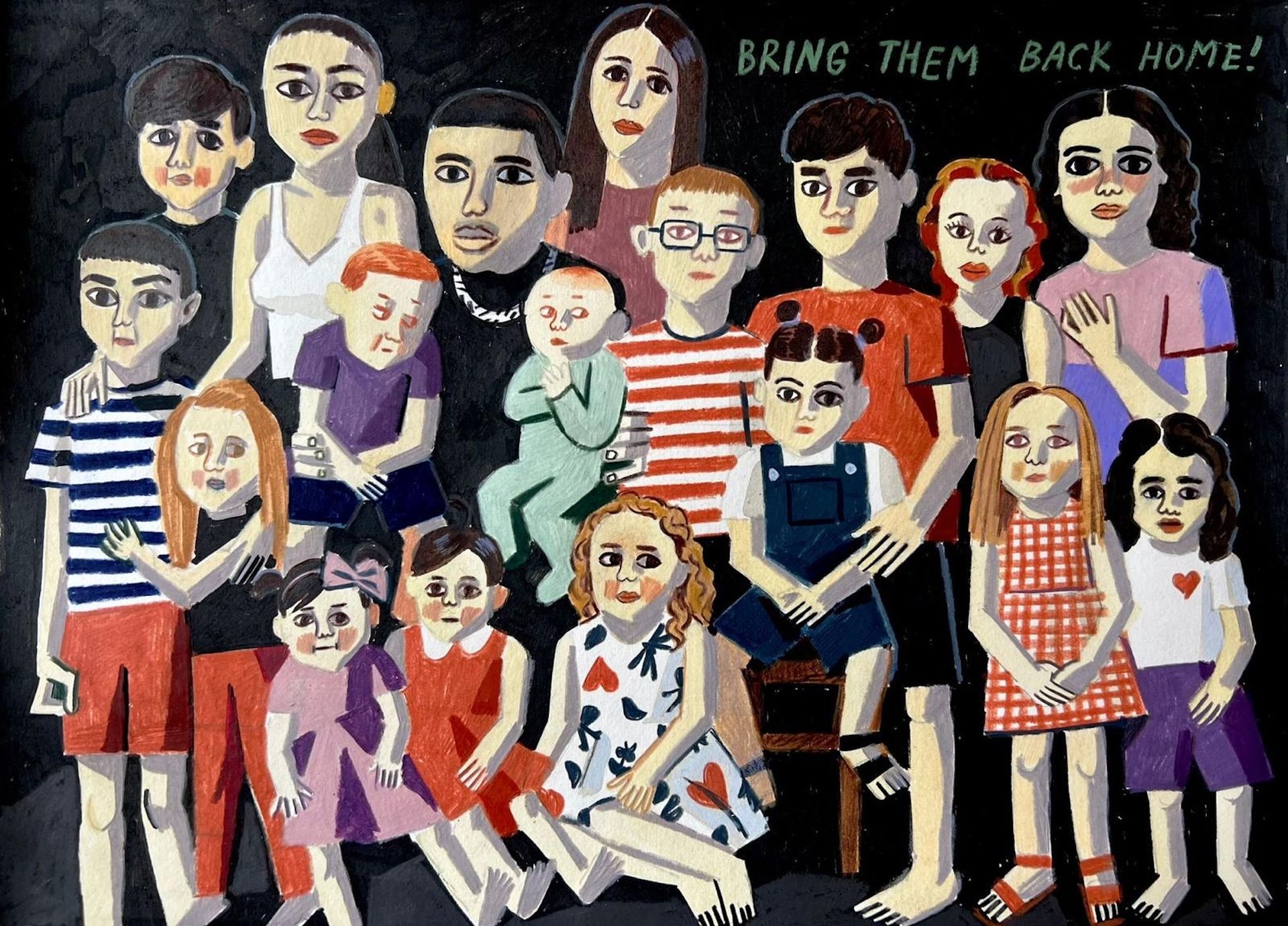After Hamas brutally attacked Israel on 7 October, killing around 1,200 people and taking more than 240 hostages, the painter Zoya Cherkassky-Nnadi fled with her eight-year-old daughter from Tel Aviv to Berlin. There, as a full picture of the attacks began to emerge, she started drawing scenes of the atrocities in a visual language that has roots in her childhood growing up in the Soviet Union. Cherkassky-Nnadi was born in Kyiv and emigrated to Israel with her family as a teenager. Last year, when Russia invaded Ukraine, she painted her birth city going up in flames.
She has always painted narrative scenes—a style she attributes to the legacy of Soviet schools, where from a young age she learned narrative composition. She paints colourful scenes of revelry and debauchery, as well as tender images of her family. And often she paints with an eye toward the lives of immigrants, particularly African communities overseas. (Her husband is Nigerian-Israeli.)
As a self-described member of the Israeli left-wing, Cherkassky-Nnadi says she has long opposed the Israeli occupation of the West Bank and the country’s current, far right-wing government. She has spoken about a contradiction she has observed in the Israeli psychology–of growing up with stories of the Holocaust but also rejecting the “other”. When Israeli settlers in the West Bank terrorised the Palestinian town of Huwara earlier this year in an attack that was later described as a “pogrom”—a word originally used in Russia to describe organised riots against Jews—Cherkassky-Nnadi painted After pogrom (2023), an image of a Palestinian family, their town in flames behind them, and Settlement Gothic (2023), a painting of a Jewish settler couple wielding a pitchfork in the vein of Grant Wood’s iconic American Gothic (1930).
In the current conflict in Gaza, which has now also claimed more than 14,000 Palestinian lives according to the Hamas-run health ministry there, Cherkassky-Nnadi sees a more complicated picture, one that demands greater nuance from a world that she believes is quick to see Israel as the aggressor, even as she recently laid blame for the 7 October attack on the Israeli government as well as on Hamas. Before the current ceasefire was brokered and Hamas began releasing hostages in exchange for Palestinian prisoners, the artist spoke with The Art Newspaper about how to draw tragedy, art world politics and her hopes for peace in the Middle East.

Zoya Cherkassky-Nnadi, 7 Oct. 2023, 2023 Courtesy of Zoya Cherkassky-Nnadi and Fort Gansevoort
The Art Newspaper: How soon after the attacks did you begin drawing?
Zoya Cherkassky-Nnadi: It was my first reaction to the war. The war in Ukraine was very similar for me. I woke up in the morning and saw that Kyiv was bombed. I’m from Kyiv. A lot of my family members still live there. The first morning [of the Israel-Hamas conflict] I was like, OK don’t worry, nothing serious is happening. But then when I saw the terrorists coming I was like, oh my god. I had friends from Russia staying in my house. They were supposed to go back the same day. We woke up because of an alarm, but in Tel Aviv it’s pretty normal. And then they told us there are terrorists coming from house to house and I thought: this cannot be. I couldn’t believe such a thing could happen—that terrorists were walking free without any interruption for so many hours. At first you think it cannot be, and then you realise what is happening is worse than you can imagine.
Your drawings show very directly the atrocities that took place on 7 October. Some people would try to forget these images, but you are drawing them. Why?
Before all of this happened, I always disrespected art as therapy. Art therapy for me was like a rude word, you know. [Laughs] But now I find myself doing it again and again. When we started to get information from Kibbutz Be’eri—the information came gradually, not in the first day—I was already in Berlin when I understood what had happened. I thought it was only Kibbutz Be’eri. Immediately, of course, my cultural memory brought me Guernica. And then there were more and more videos coming out, more and more materials. At that point I didn’t even know about the rave where there was a massacre.
It’s a big question: how do you depict suffering? How do you depict tragedy? It’s very hard not to make it kitsch. But automatically my intuition brought me this language of the Second World War, the modernist type of images associated with the Second World War. Kirchner and the German Expressionists. When I came to Berlin, we were staying near Käthe Kollwitz Platz. So I was also thinking of Käthe Kollwitz images, because she was the best at depicting the mother in times of war. There are a lot of references to art history there. Direct quotations from Guernica. And there is Munch’s Scream. And today I painted the Massacre of Innocents, based on Giotto’s painting. I use the collective memory of an artist to talk about these events.

Zoya Cherkassky-Nnadi, Massacre of the Innocents, 2023 Courtesy of Zoya Cherkassky-Nnadi and Fort Gansevoort
The figures in these paintings—are you working from descriptions or images of actual victims, or are they imagined?
I’ve seen all the images, but I didn’t work directly from particular images. I tried to avoid particular people because it’s important to me to show that it can be anyone, it’s not a particular person. The only image where I used real people was the image of kidnapped kids. When I made it, it was only known about 18 of them. Now there are over 30. Many people in Israel have asked if they can use this image for publishing or as a poster. One company in Tel Aviv has printed it really huge and it’s being used as a poster to [advocate for] bring them back.
Was your painting Massacre of the Innocents based on a particular account from the 7 October attacks?
There is an organisation, Zaka—their goal is to find the remains of the bodies, because by Jewish law the body must be buried complete. This is one of the toughest jobs, done by people that have seen things. [People from this organisation] were crying, talking about babies being murdered and decapitated, these stories of unimaginable cruelty toward small children. (Editor’s note: Israeli officials have made conflicting statements about whether or not Hamas fighters beheaded children during the 7 October attack.)
There is an image, Simchat Torah, that shows people celebrating the holiday Simchat Torah when the attacks took place, but the figures are carrying rifles.
In my city, Tel Aviv, everyone sings on the streets and throws candy from the windows. It’s a celebration of the day when the Torah was given to the Jews. And of course, everything was cancelled because of the attacks. This painting shows Simchat Torah in the kibbutz—it’s a little bit inside [debates going on] in Israel because women are not part of this celebration in Orthodox Jewish communities, and of course they don’t hold the Torah scroll. But in the kibbutz it’s different. In the kibbutz it’s celebrated in a non-religious way. They celebrate it as tradition and not religion. In the painting, there is a girl holding the scroll. They are carrying guns because people say it was unimaginable for this Holocaust scenario to happen in the state of Israel. It was the whole idea of Israel, to not be in these kinds of situations again. So what I painted was an imagined scene and a symbolic one.

Zoya Cherkassky-Nnadi, Crying female soldiers. 7 Oct. 2023., 2023 Courtesy of Zoya Cherkassky-Nnadi and Fort Gansevoort
The image of Israeli soldiers crying—is that scene also imagined?
Yes, I actually had an earlier sketch for this image, before everything that happened. It was a critical image, because it’s a sensitive, female scene of women crying, but they’re soldiers. It’s the contradiction of being Israeli. This unimaginable thing just happened [to Israelis]. But also, Israel is occupying Palestine. As a leftist I used to criticise the Israeli government and I still believe in a two-state solution. It has two faces, this image. The gentle one, of girls that have feelings. The other one: they are soldiers and they are part of a system of oppression.
Has the meaning of this image changed for you, since the 7 October attacks?
No, it’s the same. But as a member of the art world and a leftist, I have always been very critical of what’s going on in Israel and especially with this current government that no normal person likes. I posted reactions to these pogroms that happened in Huwara, the village that was set on fire by settlers. But the art world has this habit, to criticise Israel. This criticism is right because it is against the occupation. But people don’t know what happened this time. They just don’t understand. This time it’s so different and it requires a more complicated attitude, not black and white, not ‘this is good and this is bad’. Not this identity politics that says, if you are Israeli you are automatically the aggressor. When people shout “To the river to the sea, Palestine will be free”, I want to ask them: which river is that? Because I’m sure they don’t know the name of this river.

Zoya Cherkassky-Nnadi, BRING THEM BACK HOME! (The kidnapped children), 2023 Courtesy of Zoya Cherkassky-Nnadi and Fort Gansevoort
Who are these images for, ultimately?
They’re for the Israelis, to show that I see this tragedy and I understand what happened. Often we don’t even have the chance to mourn our dead because people say “what about…” Also for my friends abroad because I have a lot of friends on social networks who are not from Israel. When Artforum published that letter, it was as though the attacks never happened. It’s important to me to show what happened. I’m disappointed by the reaction of the world, because it’s so automatic. It’s also that my brain is 100% occupied with the war, so I can’t paint anything else.
To those who recognise and condemn the brutalities of 7 October but are calling for a ceasefire—an immediate end to the loss of civilian life in Gaza—what do you say?
I don’t know. I’m too confused right now. Whatever will bring our hostages back as soon as possible. I’m only sure that there must be a two-state solution in the end. This is the only way.
What is your hope for the future of Israel and Palestine?
I hope that Hamas will go down and I hope that there will be a Palestinian state along the limits [drawn in] 1967. I hope that this crazy, extreme right-wing government will be replaced by someone more normal. But this is my hope, and my fear is that everything will be even more political than it is now because people are so angry. And there are so many dead in Israel and Gaza—usually when this happens it’s a chance for more radical groups to take over. I’m afraid that’s more realistic than ever.


